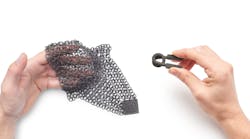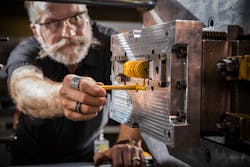Five Expert Insights into Digital Manufacturing and Mass Customization
The triumph of product standardization, a core principle of mass production, was manufacturing’s man-on-the-moon moment. As essential to industrial revolution as the division of labor and machine-assisted manufacturing, it changed everything.
Henry Ford organized his entire business around these principles, famously telling prospective car buyers, “You can have any color, as long as it’s black.”
But today’s customers aren’t buying it. One-size-fits-all doesn’t fit anymore.
Personal service providers and apparel manufacturers are leading the personalization economy. And consumer electronics aren’t far behind, with 29% of Americans saying they have personalized these products, according to our recent study.
Demand for personalized products is growing – and appears to have staying power. In fact, “off-the-shelf” is beginning to sound substandard. We all seem to want products personalized and right-sized to fit our preferences, personalities and lifestyles.
It’s a marketing trend that OEMs can’t afford to ignore. As a digital manufacturing supplier, we’ve witnessed a significant increase in leading companies who are implementing strategies to meet this new demand for customization.
We wanted to validate the trend with consumer data insight, and commissioned a national industry study this spring.
The study focused on consumer demand for small electronics: devices like smartphones, tablets and cameras. Our goal was to understand the drivers behind consumer demand for more customizable products, as well as the most sought-after upgrades and features and how preferences differ across generations.
Many of our findings were reinforced by another consumer study on personalization conducted by YouGov, an international market research and data analytic firm: “Made to Order.”
For companies striving to meet consumers’ demand for personalized products, I offer these five takeaways.
1. Millennials are the biggest personalizers.
The nation’s largest living generation – millennials – are driving demand for customized products. Personalizers, as the YouGov survey calls them, tend to be millennials (40%), highly educated (30%) and have $1,000 or more in monthly disposable income (31%). Picture a digital native, early adopter, avid live-streamer – and likely a sports fan or techie.
When it comes to smartphones, tablets, notebooks and cameras, 86% of those we surveyed found customization appealing. But there were generational differences, too: The younger the consumer, the greater their appetite for frequent product upgrades.
Almost half (46%) of millennials expect to upgrade their phones and tablets more frequently in the next five years, compared to just 32% of Gen X and 26% of baby boomers.
2. Personalization drivers are product-specific.
Personalization has long been a mainstay of the fashion industry. But what drives a consumer to personalize their running shoes can be a lot different than options on a smartphone.
In the electronic device category, our study showed that consumers’ most-wanted customization features were storage capacity, processors, screen size and style (including color and design of device exteriors and accessories).
Some consumer electronics innovators are targeting other features for customization, too – such as exact-fit headphones and ear monitors, custom-colored keyboards and joy sticks, even electric razors customized to the fit and shape of your hand.
The consumers we surveyed also expect rapid delivery of their custom small electronics. In this age of Amazon Prime, over 60% of respondents said that the item would need to arrive in three days or less for them to be completely satisfied. One in five expect overnight or even faster delivery.
Manufacturers able to meet those demands can expect a rewarding payout: 62% of those we polled said they’d be willing to pay more to customize their devices.
3. The biggest mass customization barrier is in your head.
A new world of marketing possibilities awaits companies who adopt the principles of mass customization. For example, they can easily:
- Modify catalog products for key customers
- Create unique product SKUs for specialty applications or niche markets
- Diversify accessories and add-ons to drive average sale prices
- Localize offers for global customers with distinctive needs or regulatory requirements
But to gain those advantages, they need to overcome the biggest barriers to mass customization: conventional thinking and fear of change.
Hoping to maintain the status quo in product development – from specification and iteration to prototyping and tooling – traditional manufacturers may be reluctant to make the change or investment required to automate the front-end of the manufacturing process. Yet it’s an essential step-change to enable mass customization.
Those who abide by the claim, “This is the way we’ve always done it,” will find themselves falling behind their competition. Very few of our customers belong to that group.
4. The path to mass customization is customizable.
How are companies meeting personalization demand? According to consumers of electronic devices, they’re not – or not doing it fast enough. Fewer than one-third of consumers we polled thought that most brands are prepared to meet customer expectations for fast delivery of customized small electronics.
Businesses attuned to consumer’s expectations are actively evolving their processes, using automation software integrated with connected manufacturing equipment to speed prototype creation and low-volume production runs.
These digital manufacturing tools, including agile software development, compress development time so companies can create fast iterations. They are testing, discovering and delivering customer value – far better and faster than ever before.
But where to begin? Start at the top, with a commitment from leadership to transform the manufacturing process. Then build a committee of digital decision-makers focused on integrating new digital products, platforms and services. With broad-based advocacy comes momentum for change.
Keep in mind that the transition from conventional to digital practices doesn’t necessarily mean abandoning conventional manufacturing practices. Many companies are making the digital transition gradually, folding new approaches and technologies in with conventional approaches, and contracting with digital design partners or other rapid manufacturing suppliers to supplement and accelerate product development.
For example, we’ve seen manufacturers employ rapid injection molding with conventional CNC machining to compress prototype creation from months to days. Others use 3D printing for prototyping in lieu of — or together with — conventional manufacturing processes. That practice alone can reduce lead times by 50 to 80%.
5. The upshot is reduced risk and more freedom to innovate and grow.
Companies are discovering that adopting a digital manufacturing strategy early in the design phase actually reduces risk. How? It allows them to uncover potential manufacturability issues sooner, before they’ve invested in hard tooling and production runs.
And, as our partners have shown us, front-end digitization benefits companies of all sizes, in all sectors.
I’m convinced that the demand for personalized goods – and the need for mass customization – is a trend with staying power. At a time when businesses need to differentiate their products, command premium prices and establish their relevancy with consumers, mass customization makes as much sense today as the standard black Model T Ford did at the dawn of the industrial age.
Vicki Holt is the CEO and president of Protolabs. For a look at the company's Raleigh 3D-prining operation, visit here.






